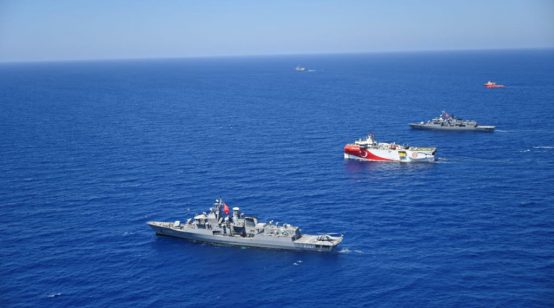
Oil and gas pipelines may now be popular news items, but that wasn’t always the case. Geopolitics is one reason: the closure of natural gas pipelines through Ukraine since 2006 has made Europeans more keenly aware of their dependence on Russia for their energy security. Climate change is another: the environmental movement and political left have coalesced on a strategy of blocking pipelines in order to stop the use of oil and gas.
This strategy has succeeded in delaying the construction of two pipelines: the Keystone XL pipeline in the central United States and the Trans Mountain pipeline in Western Canada. The delay in Trans Mountain forced the Canadian government to cut production in Alberta by 8.7%, or 325,000 barrels per day, to reduce inventories. Greenpeace activists have stopped oil tankers and pipelines in the past, but never reshaped markets.
It is noteworthy that these boycotts have been aimed at parallel pipelines, or those pipelines that run alongside existing pipelines and increase overall transport capacity. Parallel pipelines do not, in other words, disrupt pristine ecosystems.
But are these cancelations and delays as noteworthy as they seem? More importantly, are they sound strategy for those concerned about climate change?
Choking supply
Since the advent of modern drilling methods in the early 1860s, enterprising companies and individuals have sought greater economies of scale through pipelines. As the industry globalized and demand grew, parallel pipelines became as natural as having a second child. Parallel pipelines are more cost efficient, usually because they draw on better technology, but more importantly due to using the same route, loading, and export infrastructure, as well as commercial, economic, and legal models as the original.
So why are activists targeting parallel pipelines? Militants argue, in fact, that all pipelines are unsafe because leaks despoil land, vegetation, and water in local communities. These claims are founded, but controversial. On the other hand, industry proponents point out that it is far safer to move hydrocarbons overland by pipeline than trains or trucks, and oil and gas will reach markets one way or another. Environmentalists counter that this is no excuse: consumption of oil and gas in general should be reduced, if not eliminated completely.
One thing, however, is clear: by blocking pipelines on the grounds that they hurt the environment, activists have succeeded in choking supply, at least in Canada for the time being.
Canadian exceptionalism
The Canadian success is noteworthy but may be the exception that proves the rule.
Environmental concerns about parallel pipelines are, after all, confined to North America and one source: the expensive, extremely dirty Athabasca oil sands in Alberta province. These resources are not only less attractive (more expensive and dirtier to exploit) since the advent of the shale revolution, but also define what it means to be landlocked. Hundreds of kilometers from an export terminal, they must pass through Indigenous land in Western Canada and the central United States, drawing the ire of the political left.
Environmental concerns are part of public opposition to Nord Stream II. But this case further illustrates that the Alberta oil sands are exceptional. Groups in Sweden and Denmark have lobbied their governments to stop the pipeline because it will negatively disrupt wildlife in the Baltic Sea. These arguments ring hallow when Nord Stream I already exists. Another factor is that Nord Stream II is an offshore pipeline. Few people really care in these cases.
Canada must be seen as the perfect storm for halting parallel pipelines, but even this success is transitory. The Trump Administration overruled the Obama Administration in 2017 on Keystone XL and allowed the pipeline to move forward. The Liberal Canadian government, meanwhile, bought a stake in Trans Mountain in 2018 to permit its completion. Though both remain delayed, a spike in oil prices are likely to see them realized.
Second thoughts
It is ironic that parallel pipelines are attracting public attention. Shouldn’t we have blocked the construction of original pipelines instead? Knowledge about the harmful effects of oil spills and leakage is nothing new.
Environmentalists will argue that original pipelines were constructed without the consent of Indigenous peoples. This has some merit, but many Indigenous peoples enriched themselves in that process. It is hard to ignore the “not-on-my-backyard” aspect of these protests.
The pushback against parallel pipelines reveals much about human nature. People are willing to look the other way and ignore pitfalls when presented with potential riches. Most recently, people sold land willingly to U.S. shale producers. Now, when no one is benefitting except large companies and governments, opposition develops.
Good intentions
Parallel pipelines used to be the oil and gas industry’s safest investments. Now they are some of its most contentious, at least in North America.
Blocking parallel pipelines may feel noble and just, but it rests on shaky grounds, as oil and gas are likely to be used for decades. It invites more dangerous environmental consequences by forcing these products onto train and rail. It is also only successful when politicians share the sympathies of environmentalists.
We should take heart in the environmental movement’s attempts to change things from the bottom up and forcing these issues into public discussion. This is no small feat. The political and economic power of the oil and gas industry in the United States and Canada is entrenched. Yet there are better solutions, from looking to new technologies to embracing zero-carbon sources or electing politicians who care, to halt climate change than trying to choke supply by derailing the safest mode of transport.






Thank you for the new analysis. I take exception to the dirty oil cliché though, re: Alberta. 1. Eco-ists say all oil’s dirty: whatever the source, fossil fuel production/combustion creates GHGs. 2. Alberta oil is indeed carbon-heavy but when production methods are included in the calculations for ‘dirtiness’, Venezuela, Algeria, Cameroon, California and Nigeria oils have similar (or greater) GHG-intensity as Canada’s.
It should be noted that Canada is responsible for just 2% of global GHGs; the oil sands is 10% of that and 0.15% of global GHGs.
Also, the reality is that Canada’s oil sands producers are very likely the world’s most environmentally conscious and responsible oil producers. Hence the trouble getting pipelines built here.
Lasty, the oil sands industry has already achieved very significant GHG emissions cuts. As recently reported by Natural Resources Canada, technological and operational efficiency improvements enabled the industry to decrease per-barrel GHG emissions by 29 percent over the 16-year period 2000-2016. Our industry is responding to all the criticism with a great many innovations and environmental performance improvements.
Thank you!
Your comment is appreciated and well taken. Thank you for it. The Canadian oil and gas industry may well be the world’s most environmentally conscious. Norway may be its only rival for that crown.